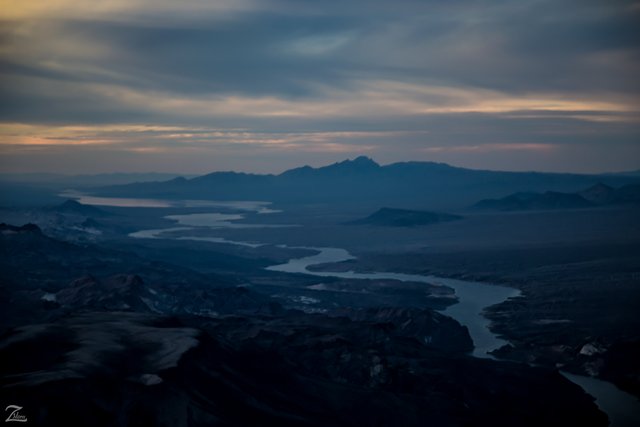Serpentine Colorado River Cutting a Path Across the Mojave Desert
While flying back from exploring the wilderness to the south of the Grand Canyon I came upon this scene. It was late in the evening and the sky was tinted beautifully with pastel alpenglow effect.
This is the Colorado River as it snakes a serpentine path cutting across the Mojave Desert over millions of years on its way south to the Gulf of California. In the distance to the middle left in this image, where the river widens, is Lake Mojave.
To the right of the river, the smaller black mountain next to the river is called Opal Mountain and behind to the right of it is Copper Mountain. The large mountains on the horizon are the Newberry Mountains and this entire area in the picture is known as Cottonwood Valley.
The Colorado River is one of the principal rivers of the Southwestern United States and northern Mexico (the other being the Rio Grande). The 1,450-mile-long (2,330 km) river drains an expansive, arid watershed that encompasses parts of seven U.S. and two Mexican states. Starting in the central Rocky Mountains in the U.S., the river flows generally southwest across the Colorado Plateau and through the Grand Canyon before reaching Lake Mead on the Arizona–Nevada border, where it turns south toward the international border. After entering Mexico, the Colorado approaches the mostly dry Colorado River Delta at the tip of the Gulf of California between Baja California and Sonora.
Beginning with small bands of nomadic hunter-gatherers, Native Americans have inhabited the Colorado River basin for at least 8,000 years. Between 2,000 and 1,000 years ago, the river and its tributaries fostered large agricultural civilizations – some of the most sophisticated indigenous cultures in North America – which eventually faded due to a combination of severe drought and poor land use practices.
Most native peoples that inhabit the basin today are descended from other groups that settled in the region beginning about 1,000 years ago. Europeans first entered the Colorado Basin in the 16th century, when explorers from Spain began mapping and claiming the area, which later became part of Mexico upon its independence in 1821. Early contact between Europeans and Native Americans was generally limited to the fur trade in the headwaters and sporadic trade interactions along the lower river.
(Research Source)
This image is from my ongoing project in which I am trying to raise awareness of the 47% of the USA and 90% of Canada that remain unpopulated wilderness.
Where Eagles Fly - The American Wilderness Expedition is my personal mission to introduce people to these amazing locations that surround us.
If you like what you see here upvote then resteemit so that others may experience these wondrous places as well. And if you'd like these images to be part of your feed then follow me.
Yehaw!!

great
Nice 💕
Cool view!
Great quality photo's that can only be taken from a very very high mountain or your plane!
I love the view, nature pics are really my favourite.
nice photography
Keep your love of nature, for that is the true way to understand art more and more.
Look deep into nature, and then you will understand everything better.
Keep your love of nature, for that is the true way to understand art more and more.
Look deep into nature, and then you will understand everything better.
Study nature, love nature, stay close to nature. It will never fail you.